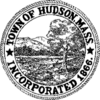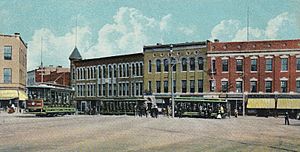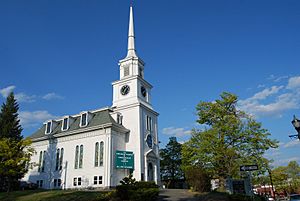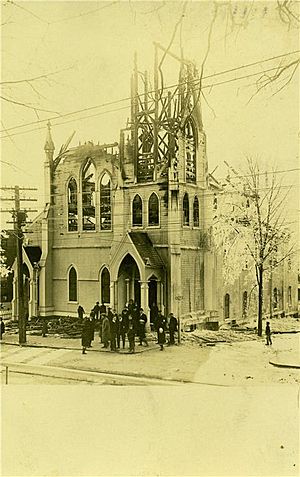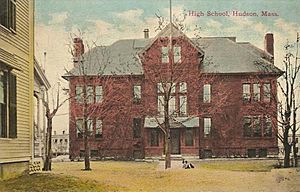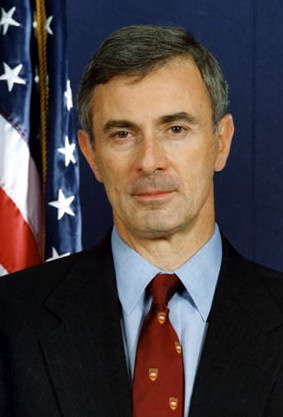Hudson, Massachusetts facts for kids
Quick facts for kids
Hudson, Massachusetts
|
||
|---|---|---|
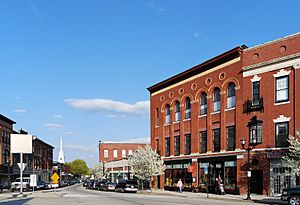
Wood Square
|
||
|
||
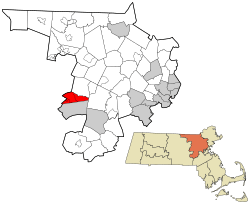
Location in Middlesex County in Massachusetts
|
||
| Country | United States | |
| State | Massachusetts | |
| County | Middlesex | |
| Settled | 1698 | |
| Incorporated | 1866 | |
| Government | ||
| • Type | Open town meeting | |
| Area | ||
| • Total | 11.8 sq mi (30.7 km2) | |
| • Land | 11.5 sq mi (29.8 km2) | |
| • Water | 0.3 sq mi (0.9 km2) | |
| Elevation | 263 ft (80 m) | |
| Population
(2020)
|
||
| • Total | 20,092 | |
| • Density | 1,747.1/sq mi (674.2/km2) | |
| Time zone | UTC-5 (Eastern) | |
| • Summer (DST) | UTC-4 (Eastern) | |
| ZIP code |
01749
|
|
| Area code(s) | 351 / 978 | |
| FIPS code | 25-31540 | |
Hudson is a town in Middlesex County, Massachusetts, United States, with a total population of 20,092 as of the 2020 census. Before its incorporation as a town in 1866, Hudson was a neighborhood and unincorporated village of Marlborough, Massachusetts, and was known as Feltonville. From around 1850 until the last shoe factory burned down in 1968, Hudson was a mill town specializing in the production of shoes and related products. At one point the town had 17 shoe factories, many of them powered by the Assabet River, which runs through town. The many factories in Hudson attracted immigrants from Canada and Europe. Today most residents are of either Portuguese or Irish descent, with a smaller percentage being of French, Italian, English, or Scotch-Irish descent. While some manufacturing remains in Hudson, the town is now primarily residential. Hudson is served by the Hudson Public Schools district.
Contents
History
In 1650, the area that would become Hudson was part of the Indian Plantation for the Praying Indians. The Praying Indians were evicted from their plantation during King Philip's War, and most did not return even after the war ended.
The first European settlement of the Hudson area occurred in 1699 when settler John Barnes, who had been granted an acre of the Ockookangansett Indian plantation the year before, built a gristmill on the Assabet River on land that would one day be part of Hudson. By 1701, Barnes had also built a sawmill on the river and had built a bridge across it. Over the next century, Hudson grew slowly.
Hudson was part of the town of Marlborough and was known as Feltonville for part of that time, until its incorporation as a separate municipality in 1866. As early as June 1743 Hudson-area residents petitioned to break away from Marlborough and become a separate town, but this petition was denied by the Massachusetts General Court. Men from the present Hudson area fought with the Minutemen on April 19, 1775.
In the 1850s, Feltonville received its first railroads. The town of Hudson had two train stations, originally operated by the Central Massachusetts Railroad Company and later by Boston & Maine, until both of them were closed in 1965. This allowed the development of larger factories, some of the first in the country to use steam power and sewing machines. By 1860, Feltonville had 17 shoe and shoe-related factories, which attracted immigrants from Ireland and French Canada.
Feltonville residents, as Massachusetts recruits fought during the Civil War for the Union, with twenty-five men dying doing so. Two houses, including the Goodale Homestead on Chestnut Street (Hudson's oldest building, dating from 1702) and the Curley home on Brigham Street (formerly known as the Rice Farm), have been cited as way-stations on the Underground Railroad.
In 1865, Hudson-area residents again petitioned for Feltonville to become a separate town. This petition was approved by the Massachusetts General Court on March 19, 1866. The new town was named Hudson after Charles Hudson, who donated $500 to the new town for it to build a library, on the condition that the newly incorporated town be named after him.
Over the next twenty years, Hudson grew as several industries settled in town. Two woolen mills, an elastic-webbing plant, a piano case factory, and a factory for waterproofing fabrics by rubber coating were built, as well as banks, five schools, a poor farm, and the town hall that is still in use today. The population hovered around 5,500 residents, most of whom lived in small houses with small backyard garden plots. The town maintained five volunteer fire companies, one of which manned the Eureka Hand Pump, a record-setting pump that could shoot a 1.5-inch (38 mm) stream of water 229 feet (70 m).
On July 4, 1894, a fire started by two boys playing with firecrackers disastrously burned down 40 buildings and 5 acres (20,000 m2) of central Hudson. Nobody was hurt, but the damages were estimated at $400,000 (1894 dollars). The town was substantially rebuilt within a year or two.
By 1900, Hudson's population reached about 7,500 residents, and the town had built a power plant, so some houses were wired for electricity. Electric trolley lines were built that connected Hudson with the towns of Leominster, Concord, and Marlborough. The factories in town continued to grow, attracting immigrants from England, Germany, Portugal, Lithuania, Poland, Greece, Albania, and Italy. These immigrants usually lived in boarding houses near their places of employment. By 1928, 19 languages were spoken by the workers of the Firestone-Apsley Rubber Company. Today, the majority of Hudson residents are of Irish or Portuguese descent, with lesser populations of Italian, French, English, Scots-Irish, and Greek descent. About one-third of Hudson residents are Portuguese or are of Portuguese descent. Most people of Portuguese descent in Hudson are from the Azorean island of Santa Maria, with a smaller amount from the island of São Miguel or from the Trás-os-Montes region of mainland Portugal. The Portuguese community in Hudson maintains the Hudson Portuguese Club, who, in 2001, rebuilt a state-of-the-art clubhouse. The Hudson Portuguese Club was established in the mid-1910s and has outlived several other ethnic clubs, such as the town's long-gone Italian Club. Recent immigrants to Hudson arrive mainly from Mexico, Central America, Brazil, and other South American countries, as well as Asia, and Europe.
Hudson's population remained about the same until after World War II, when developers purchased some farms that surrounded the town center. The new houses that were built on this land more than doubled Hudson's population. Recently, high-technology companies have built plants, notably the semiconductor fabrication factory that Digital Equipment Corporation built (now owned by Intel). Although the population of Hudson is now about 20,000, the town continues traditional town meeting form of government.
Former names
Feltonville was the name of what is today the town of Hudson, Massachusetts. Before becoming a separate incorporated town, Hudson was a neighborhood and unincorporated village within the town of Marlborough, Massachusetts, known as Feltonville. The name was derived from the name of Silas Felton (1776-1828), who operated a dry goods store in the hamlet from 1801 onward, served many years as selectman, town clerk, town assessor, and in 1828 became the first postmaster. The name was used from 1828 until the town was incorporated as Hudson in 1866. Today, the Felton name is found in the Silas Felton Hudson Historic District and two street names: Felton Street and Feltonville Road.
Hudson has had other, earlier names:
- From 1656 until 1700, present-day Hudson and the surrounding area was known as the Indian Plantation or the Cow Commons.
- From 1700 to 1800, the settlement was known as The Mills.
- From 1800 to 1828, the settlement was called New City.
Geography
According to the United States Census Bureau, the town has a total area of 11.8 square miles (30.7 km²), of which 11.5 square miles (29.8 km²) is land and 0.3 square mile (0.9 km²) (2.87%) is water.
The Assabet River flows through the town. On the border with Stow is Lake Boon, once a popular vacation spot but now a primarily residential neighborhood. On the border with Marlborough is Fort Meadow Reservoir, which at one time provided drinking water to both Hudson and Marlborough.
Adjacent towns
Hudson is bordered by five other towns:
Bolton and Stow on the north, Marlborough on the south, Sudbury on the east, and Berlin on the west.
Villages
The neighborhood and unincorporated village of Gleasondale straddles both Hudson and Stow.
Demographics
| Historical population | ||
|---|---|---|
| Year | Pop. | ±% |
| 1870 | 3,389 | — |
| 1880 | 3,739 | +10.3% |
| 1890 | 4,670 | +24.9% |
| 1900 | 5,454 | +16.8% |
| 1910 | 6,743 | +23.6% |
| 1920 | 7,607 | +12.8% |
| 1930 | 8,460 | +11.2% |
| 1940 | 8,042 | −4.9% |
| 1950 | 8,211 | +2.1% |
| 1960 | 9,666 | +17.7% |
| 1970 | 16,084 | +66.4% |
| 1980 | 16,408 | +2.0% |
| 1990 | 17,233 | +5.0% |
| 2000 | 18,113 | +5.1% |
| 2010 | 19,063 | +5.2% |
| 2020 | 20,092 | +5.4% |
| * = population estimate. Source: United States Census records and Population Estimates Program data. | ||
As of the 2000 census, there were 18,113 people, 6,990 households, and 4,844 families residing in the town. The population density was 1,574.4 people per square mile (608.1/km2). There were 7,168 housing units at an average density of 623.0 per square mile (240.7/km2). The racial makeup of the town was 94.12% White, 0.91% Black or African American, 0.13% Native American, 1.40% Asian, 0.06% Pacific Islander, 1.40% from other races, and 1.98% from two or more races. Hispanic or Latino of any race were 3.06% of the population.
There were 6,990 households, out of which 32.0% had children under the age of 18 living with them, 56.7% were married couples living together, 9.2% had a female householder with no husband present, and 30.7% were non-families. 25.2% of all households were made up of individuals, and 9.5% had someone living alone who was 65 years of age or older. The average household size was 2.57 and the average family size was 3.11.
In the town, the population was spread out, with 24.0% under the age of 18, 6.7% from 18 to 24, 33.5% from 25 to 44, 23.6% from 45 to 64, and 12.2% who were 65 years of age or older. The median age was 37 years. For every 100 females, there were 97.8 males. For every 100 females age 18 and over, there were 94.6 males.
The median income for a household in the town was $58,549, and the median income for a family was $70,145. Males had a median income of $45,504 versus $35,207 for females. The per capita income for the town was $26,679. About 2.7% of families and 4.5% of the population were below the poverty line, including 3.8% of those under age 18 and 8.7% of those age 65 or over.
As of 2017 Census Bureau estimates, Hudson's population increased to 19,994. The town's racial makeup was 92.6% white, 1.3% Black or African American, 0.1% Native American, 2.7% Asian, and 2.5% from two or more races, with Hispanic or Latino people of any race making up 6.7% of the population.
Education
According to 2017 Census Bureau estimates, 90.3% of Hudson residents graduated high school or higher, while 39.8% have a bachelor's degree or higher. The Census Bureau estimated that in the five-year period between 2013 and 2017, 86.3% of Hudson households had a broadband internet subscription.
Library
The Hudson public library first opened in 1867. In fiscal year 2008, the town of Hudson spent 1.19% ($614,743) of its budget on its public library—some $31 per person.
Transportation
Road transportation
Here are the highways that run through Hudson:
Air transportation
Hudson has no airport of its own. The closest airport of any type is Marlboro Airport in Marlborough, the closest with scheduled flights is Worcester Regional Airport in Worcester and the closest with international service is Logan International Airport in Boston.
Bus transportation
Hudson has been a candidate of bus transportation, along with Milford.
Religion
Houses of worship
- Saint Michael's Roman Catholic Church . St. Michael's Church, also known as St. Mike's, has been in existence since 1869, with the present building having been built in 1889. The current pastor is Rev. Ron Calhoun, and the Xaverian assistant is Rev. Anthony Lalli.
- Saint Luke's Episcopal Church . St. Luke's Church was completed in 1913, and the current rector is Rev. T. James Kodera.
- First United Methodist Church of Hudson . The current Methodist Church in town was completed in 1913 after the first one, which was located across the street from the Unitarian Church, burnt down in 1911. The current pastor is Pastor Rosanne Roberts
- Unitarian Church of Marlborough and Hudson. The Unitarian Church is technically older than the town itself; it was built in 1861. The current minister is Rev. Alice Anacheka-Nasemann.
- Grace Baptist (Southern Baptist) Church. Grace Baptist was built in 1986 and the congregation has grown from an original 25 to a current 1,200 members. The current (senior) pastor is Rev. Marc Pena.
- Carmel Marthoma Church. The newest church in Hudson, the Carmel Marthoma Church was constructed in 2001, but the congregation traces its beginnings to the early 1970s as a prayer fellowship, meeting in the greater Boston area.
- First Federated Church (Baptist/Congregational). The First Federated Church was built in the 1960s. The current pastor of the First Federated Church is Rev. James (Jay) E. Mulligan III.
- Hudson. The Seventh-day Adventist Church was also built in the 1960s.
- Hudson also has a Buddhist meeting group affiliated with the SGI.
Churches no longer in use
- Christ the King Roman Catholic Church (merged with Saint Michael's Church in 1994 to form one parish) As the parish had been suppressed in 1994 it was determined by the pastor, Fr. Walter A. Carreiro, with the Parish Pastoral Council to suspend the church building's use for worship. At the same time the St. Michael Early Childhood Center, located in a building on the same property, was relocated to Saint Michael School. Christ the King was not closed by the Archdiocese and proceeds of its subsequent sale reverted directly to Saint Michael parish.
- Union Church of All Faiths, possibly the smallest church in the US, built by the Rev. Louis W. West
A very small fraction of the town's population is Jewish and Orthodox, but there is not yet a synagogue or an Orthodox church in Hudson. Hudson nevertheless has an important role in the formation of the Albanian Orthodox Church due to the 1906 Hudson incident in which an Albanian national was refused burial by a Greek Orthodox priest from Hudson.
Education
Hudson's local public school district is Hudson Public Schools, a district open to Hudson residents and through school choice to any area students. The superintendent of Hudson Public Schools is Dr. Marco C. Rodrigues. Prior to starting ninth grade Hudson students may choose to attend either Hudson High School or Assabet Valley Regional Technical High School. Assabet Valley Regional Technical High School is open to students from Berlin, Hudson, Maynard, Northborough, Southborough, Westborough, and Marlborough.
Schools
- Camela A. Farley Elementary School
- Forest Avenue Elementary School
- Joseph L. Mulready Elementary School
- David J. Quinn Middle School
- Hudson High School
Private schools
- Saint Michael's School was a private Catholic primary school that served grades 1 through 8 as well as kindergarten. The original building was built in 1918, when the school was founded, and the school was administered by Saint Michael's Catholic Parish. When Hudson Catholic High School closed in 2009, Saint Michael's School moved to the former HCHS building. In May 2011 the parish announced the school would close at the end of the school year. The original St. Michael's School building stood empty for a few years before the parish demolished it to expand its existing parking lot.
- Hudson Catholic High School (HCHS) was a private Catholic high school that served grades 9 through 12. It was completed in 1959 and was administered by Saint Michael's Catholic Parish. The principal was Caroline Flynn and the assistant principal was Mark Wentworth at the school's closure. The parish announced only about a month before the end of the 2008–2009 school year that the school would be closed by the Boston Archdiocese due to lack of enrollment—and, as a consequence, funds—for the 2009–2010 school year. The HCHS building was then used as the Saint Michael's School building, which itself closed in May 2011, and has since been demolished. The parish sold the former HCHS lot, on which now stands a Walgreens pharmacy.
- A former private Catholic school district known as Saint Michael's Schools and administered by Saint Michael's Catholic Parish closed in 2011.
Notable people
- Lewis Dewart Apsley, founder of Apsley Rubber Company; U.S. Congressman from Massachusetts from 1893 to 1897
- Luís Gil Bettencourt, traditional and rock guitarist; older brother of Nuno Bettencourt
- Nuno Bettencourt, rock musician; lead guitarist for the band Extreme
- Matt Burke, former defensive coordinator for the Miami Dolphins, raised in Hudson and graduated from Hudson High School
- Tina Cardinale-Beauchemin, captain of the first United States women's national ice hockey team
- Paul Cellucci, Governor of Massachusetts from 1997 to 2001 and United States Ambassador to Canada from 2001 to 2005
- Shaye Cogan, singer, vaudevillian, and film actor popular in the 1950s
- William D. Coolidge, physicist who invented an improved X-ray tube, developed the tungsten filament for the incandescent light bulb, was vice-president of General Electric, and was elected to the National Inventors Hall of Fame in 1975
- Hugo Ferreira, rock musician; singer-songwriter for the band Tantric
- Kevin Figueiredo, rock drummer; drummer for the band Extreme
- Johnny Gilroy, All-American football halfback at Georgetown University and professional player during the 1920s for the Canton Bulldogs, Cleveland Tigers, Washington Senators, and Boston Bulldogs
- Pete Manning, professional American and Canadian football player during the 1960s for the Chicago Bears, Calgary Stampeders, and Toronto Argonauts
- Evan Markopoulos, professional wrestler of TNA Gut Check fame
- Marykate O'Neil, indie-pop singer-songwriter and guitarist
- Charles Precourt, retired U.S. astronaut
- William B. Rice, industrialist and businessman who co-founded Rice & Hutchins, a shoe manufacturing company
- Wilbert Robinson, catcher for various Major League Baseball teams; best known for being manager of the Brooklyn Dodgers from 1914 to 1931; inducted into the Baseball Hall of Fame in 1945; born in Bolton but raised in Hudson
- Paul Ryan, comic artist on Fantastic Four and The Phantom; born in Somerville but a long-time Hudson resident until his death in 2016
- Thomas P. Salmon, Governor of Vermont from 1973 to 1977; born in Cleveland, Ohio, raised in Stow, and attended Hudson High School
- William C. Sullivan, former head of FBI intelligence operations
- Lucy Goodale Thurston, one of the first American Protestant missionaries in Hawaii
- Burton Kendall Wheeler, U.S. Senator from Montana from 1923 to 1947
Images for kids
-
Hudson Public Library in 1907, a Carnegie library opened in 1905
See also
 In Spanish: Hudson (Massachusetts) para niños
In Spanish: Hudson (Massachusetts) para niños


